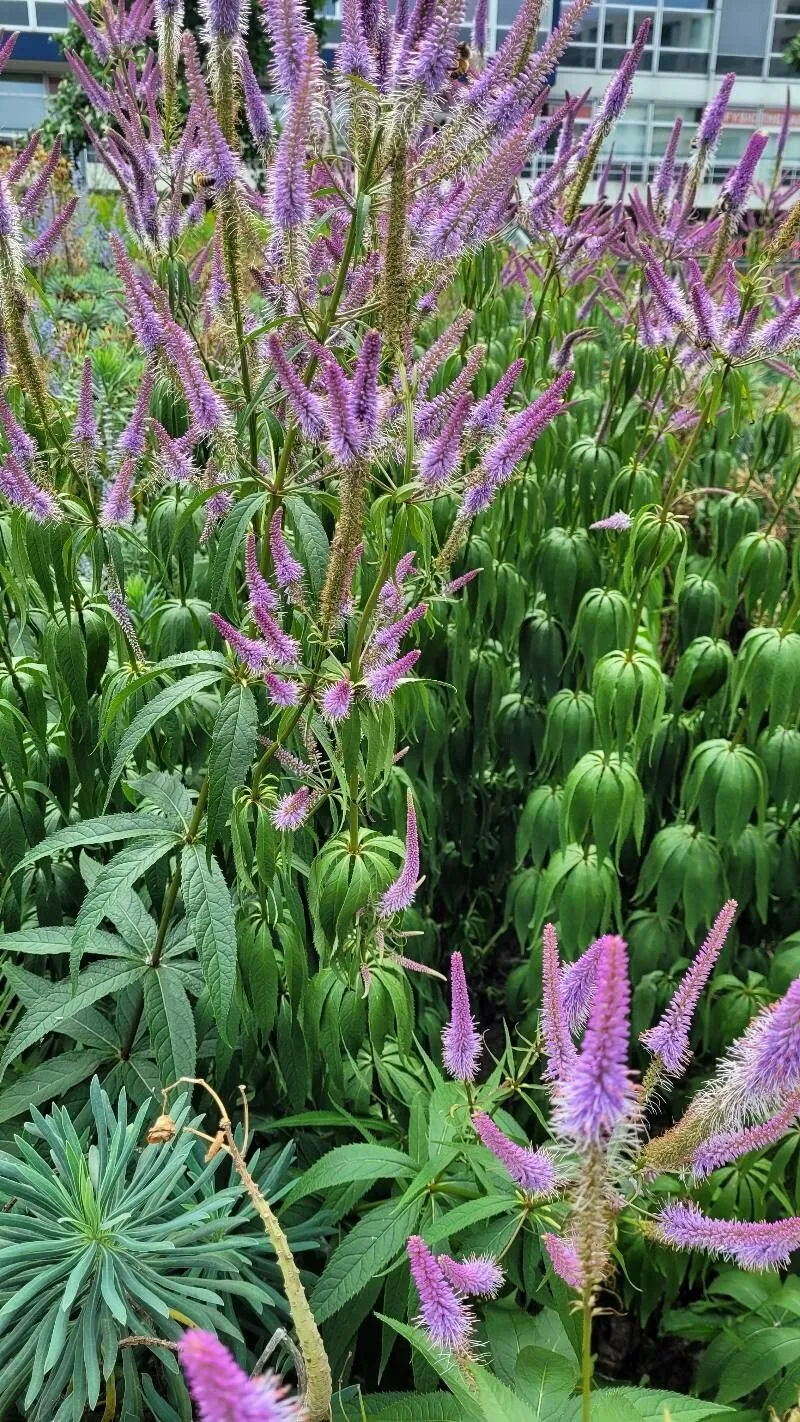
Author: (L.) Farw.
Bibliography: Druggists’ Circ. 61: 231 (1917)
Year: 1917
Status: accepted
Rank: species
Genus: Veronicastrum
Vegetable: False
Observations: C. & E. Canada to C. & E. U.S.A.
Culver’s-root, scientifically known as Veronicastrum virginicum, is an elegant and robust perennial native to central and eastern parts of Canada and the United States. This striking member of the Plantaginaceae family stands out in the wild as well as in cultivated gardens for its tall, slender form and spectacular flower spikes.
The plant typically reaches heights of up to 5 to 6 feet, making it a commanding presence in any landscape. Culver’s-root prefers moist to wet soils and often thrives in meadows, prairies, and woodland edges. One of its defining features is the elegant whorls of lanceolate leaves that encircle the stem at regular intervals. These leaves provide a refined backdrop to the plant’s brilliant inflorescence.
The flowering period of Culver’s-root is a summer spectacle, usually spanning from July to August. Its blooms are densely packed on towering spikes, exhibiting delicate, tiny, tubular flowers that range in color from white to light lavender. These upright flower clusters are not only visually impressive but also attract a variety of pollinators, including bees and butterflies.
Historically, Culver’s-root has garnered attention not only for its ornamental value but also for its medicinal properties. The root of the plant was traditionally used by Native Americans and later by settlers as a purgative and liver tonic. Documented references to its medicinal uses can be found in historical pharmacological texts such as “Druggists’ Circular” published in 1917.
In a garden setting, Culver’s-root is versatile and can be used to add height and structure to flower beds and borders. It pairs well with other tall perennials like Joe-Pye weed, goldenrod, and various grasses, creating a dynamic and textured landscape. Its resilience and adaptability also make it a valuable choice for gardeners seeking to incorporate native plants into their designs, promoting biodiversity and supporting local ecosystems.
Cultivating Culver’s-root requires minimal effort once established. It benefits from full to partial sunlight and appreciates consistent moisture. While it can endure short periods of drought, regular watering will ensure lush growth and prolific flowering. Deer resistance is another merit, making it a favorable option for gardens in areas with prevalent wildlife.
Overall, Veronicastrum virginicum, or Culver’s-root, is a remarkable plant that offers both aesthetic appeal and ecological benefits. Its high stature, intricate flower spikes, and ability to attract pollinators make it a standout species worthy of admiration and conservation.
Eng: blackroot, bowman’s-root, culver’s root, culver’s-root, tall-speedwell, tall speedwell, virginia culver’s root
Swe: kransveronika
Fra: véronique de virgine, véronicastre de virginie
En: Culver’s-root, Bowman’s-root, Tall-speedwell, Blackroot, Culver’s root, CULVERPSYIC, Virginia Culver’s root, Tall speedwell
Cs: Rozrazil virginský
Fi: Virginiantädykkö
Fr: Véronique de Virgine, Véronicastre de Virginie
Ru: Вероникаструм виргинский
Sv: Kransveronika
© copyright of the Board of Trustees of the Royal Botanic Gardens, Kew.
Taken Jul 8, 2020 by Dieter Albrecht (cc-by-sa)
Taken Aug 26, 2021 by Bert Doornekamp (cc-by-sa)
Taken Jun 18, 2020 by Gey WASSON (cc-by-sa)
Taken Aug 18, 2021 by Francesca Zingoni (cc-by-sa)
Taken Aug 13, 2021 by nathy15 nathy15 (cc-by-sa)
Taken Jun 25, 2019 by Norbert Scherer (cc-by-sa)
Taken Aug 1, 2019 by Castiglione Francis (cc-by-sa)
Taken Aug 30, 2021 by Pieter Verbrugghe (cc-by-sa)
Taken Jul 8, 2021 by Hélène lowinger (cc-by-sa)
Taken Jul 17, 2021 by Jos Giesen (cc-by-sa)
Taken Sep 2, 2021 by Schilling Annette (cc-by-sa)
Taken Oct 22, 2020 by Ha Anna (cc-by-sa)
Taken Sep 22, 2020 by Dieter Albrecht (cc-by-sa)
Taken Aug 18, 2021 by Horsch Florian (cc-by-sa)
Taken Aug 15, 2022 by Leonard F.W.D (cc-by-sa)
Taken Aug 12, 2015 by EOL − riveredgenature (cc-by-nc)
Taken Aug 14, 2015 by EOL − Aarongunnar (cc-by-nc)
Taken Jul 22, 2014 by EOL − schock1 (cc-by-nc)
Taken Jul 31, 2014 by EOL − Kathy Leonard (cc-by-nc)
Taken Jul 9, 2022 by jonawel (cc-by-sa)
Taken Jul 8, 2020 by Dieter Albrecht (cc-by-sa)
Taken Jun 15, 2020 by Dieter Albrecht (cc-by-sa)
Taken Jul 7, 2022 by Dieter Albrecht (cc-by-sa)
Taken May 16, 2020 by grutz (cc-by-sa)
Taken Jul 12, 2010 by EOL − Ron Thomas (cc-by-nc-sa)
Taken Jul 2, 2021 by Nicole Thäsler (cc-by-sa)
Taken Jul 4, 2019 by Wilhelm Rogmann (cc-by-sa)
Taken Jul 15, 2021 by Tammy Sessanna (cc-by-sa)
Taken Jul 28, 2020 by Anne Van Langendonck (cc-by-sa)
Taken Aug 10, 2021 by AnnA (cc-by-sa)
Growth habit>: Forb/herb
Family: Myrtaceae Author: (F.Muell.) K.D.Hill & L.A.S.Johnson Bibliography: Telopea 6: 402 (1995) Year: 1995 Status:…
Family: Rubiaceae Author: Pierre ex A.Froehner Bibliography: Notizbl. Bot. Gart. Berlin-Dahlem 1: 237 (1897) Year:…
Family: Sapindaceae Author: Koidz. Bibliography: J. Coll. Sci. Imp. Univ. Tokyo 32(1): 38 (1911) Year:…
Family: Asteraceae Author: A.Gray Bibliography: Pacif. Railr. Rep.: 107 (1857) Year: 1857 Status: accepted Rank:…
Family: Fabaceae Author: Medik. Bibliography: Vorles. Churpfälz. Phys.-Ökon. Ges. 2: 398 (1787) Year: 1787 Status:…
Family: Aspleniaceae Author: (Cav.) Alston Bibliography: Bull. Misc. Inform. Kew 1932: 309 (1932) Year: 1932…